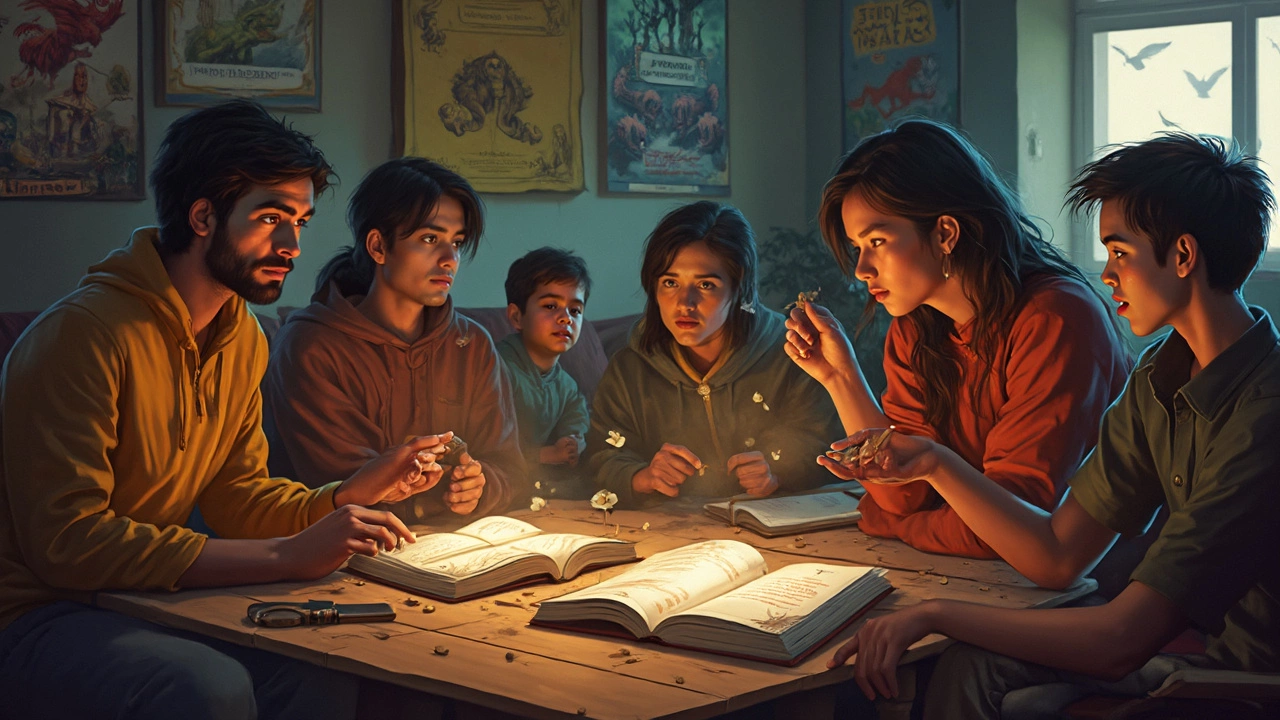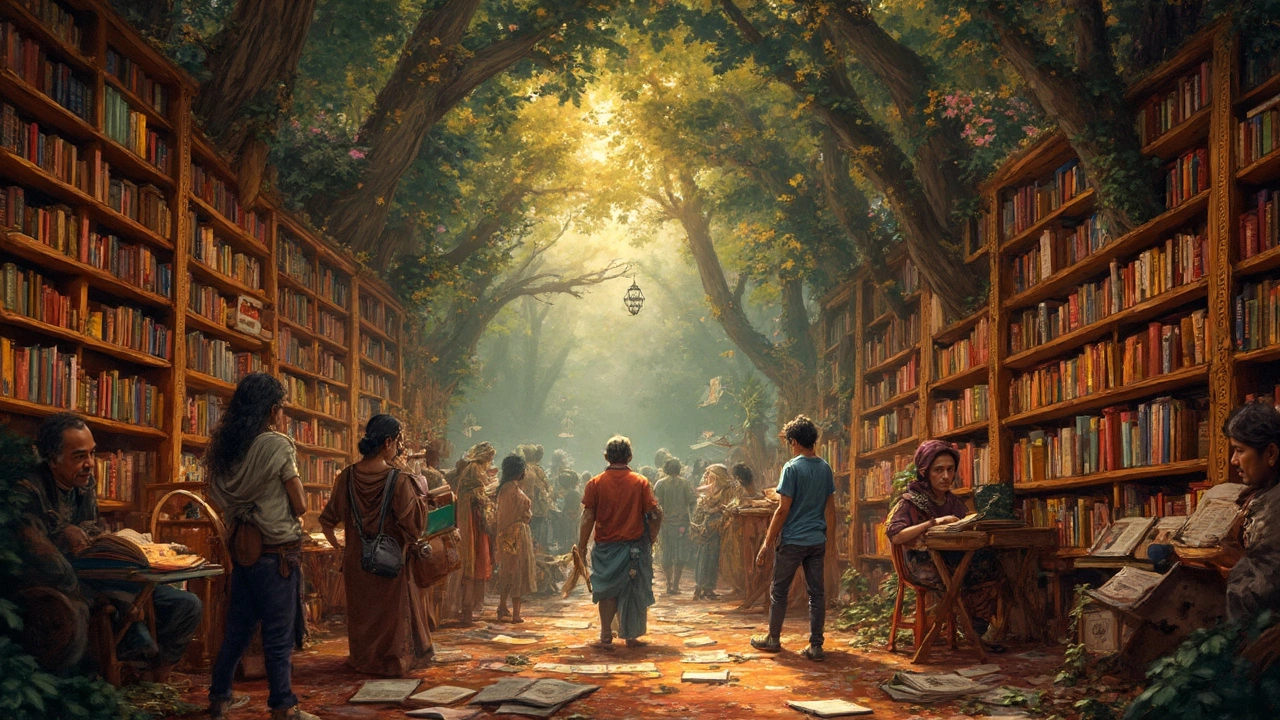Big fantasy stories didn’t just pop up out of nowhere. If you love dragons, epic battles, or dark swordsmen, you owe a lot to the Big 3 fantasy writers: J.R.R. Tolkien, C.S. Lewis, and Robert E. Howard. These guys didn’t follow someone else’s formula—they basically built the blueprint for modern fantasy. Their work is the reason your favorite video game, blockbuster movie, or fat fantasy series even exists.
People might argue about who deserves to be in the top three, but these names always rise to the top for a reason. Tolkien created entire languages and deep histories for a world that still feels more real than some memories. Lewis put wild adventures and magic into stories you could use to spark real-life thinking—for kids and adults alike. Howard cranked up the action, turning raw swordplay and pulpy, fast-paced adventure into Conan and everything that came after. Each had their own style, but they all knew how to keep readers glued to the page.
- Why the 'Big 3' Matter
- J.R.R. Tolkien: The Master World-Builder
- C.S. Lewis: Mixing Magic with Meaning
- Robert E. Howard: Pulp Adventure’s King
- Where to Start Reading Their Work
- Spotting Their Legacy in Today’s Fantasy
Why the 'Big 3' Matter
If you’re wondering why people keep talking about the so-called Big 3 fantasy writers, here’s the deal: without them, the fantasy section at your local bookstore would look very different. They set up all the core ideas—world-building, rules of magic, epic quests, and memorable heroes—that everyone else uses now. Even today’s top-selling fantasy novels borrow stuff these guys invented decades ago.
Back in the 1930s to 1950s, most stories about magic and monsters were stuck in fairytales or pulp magazines. Once Tolkien, Lewis, and Howard hit the scene, they actually made fantasy cool for adults and kids, not just for bedtime stories. For example, after Tolkien published 'The Lord of the Rings' in the 1950s, fantasy book sales exploded. Publishers noticed, and soon fantasy was everywhere. Some of the best-selling fantasy authors now, like J.K. Rowling and George R.R. Martin, have said these three were huge influences.
Check out these numbers for proof:
| Writer | Key Work(s) | Estimated Copies Sold |
|---|---|---|
| J.R.R. Tolkien | The Lord of the Rings | Over 150 million |
| C.S. Lewis | The Chronicles of Narnia | Over 100 million |
| Robert E. Howard | Conan Stories | Over 50 million (across stories, collections, and spin-offs) |
A lot of fantasy tropes started with them. Tolkien gave us elves and dwarves that people still copy; Lewis made parallel worlds and talking animals a thing; Howard’s sword-and-sorcery adventures set the pace for countless action-packed tales. That’s why, even after almost a hundred years, their books are still in print and their ideas show up everywhere—movies, games, TV shows, you name it.
J.R.R. Tolkien: The Master World-Builder
If you’ve ever gotten totally lost in a fictional universe, you probably have Tolkien to thank for setting the standard. He’s the guy who created Middle-earth, packed it full of orcs, elves, dwarves, and a crazy amount of backstory. Tolkien started off as a professor at Oxford, teaching Old English and studying languages. That geeky interest in words and history paid off when he wrote The Lord of the Rings and The Hobbit—two books that pretty much everyone on the planet has heard of.
Tolkien didn’t just write stories; he built whole languages from scratch, like Elvish and Dwarvish, and even wrote grammar rules for them. That’s why Middle-earth feels so deep—there’s a sense of history that most other fantasy novels can’t match. The Lord of the Rings alone has sold over 150 million copies. If you look at readership and adaptations, the numbers get even higher:
| Book | Publication Year | Estimated Sales | Film Adaptation |
|---|---|---|---|
| The Hobbit | 1937 | Over 100 million | Yes, 2012–2014 |
| The Lord of the Rings | 1954-1955 | Over 150 million | Yes, 2001–2003 |
The coolest thing? Tolkien didn’t even see himself as a fantasy writer, just a guy sharing the worlds he imagined. He spent years building up notebooks full of maps and timelines. His son, Christopher, later published a ton of material Tolkien never finished, including The Silmarillion. If you want to go deep, there’s so much more than just the main books.
Reading Tolkien isn’t always easy—he digs into long songs or detailed history at the drop of a hat. If you’re new, start with The Hobbit. It’s short, fun, and sets up everything. Once you’ve got that under your belt, you’ll notice how much of modern fantasy steals, pays tribute to, or tweaks his basic ideas. Game of Thrones, Dungeons & Dragons, all those movies filled with elves—none of that would exist like it does without Tolkien’s deep world-building.
C.S. Lewis: Mixing Magic with Meaning
C.S. Lewis might not have invented fantasy, but he sure knew how to make it matter. His secret? Wrapping big ideas inside magical stories that even kids could enjoy—without feeling like homework. His most famous work, "The Chronicles of Narnia," is basically a gateway series for anyone just getting their feet wet with fantasy novels.
The first Narnia book, "The Lion, the Witch and the Wardrobe," has sold over 85 million copies worldwide. That puts it up there with the top sellers in any genre, and it still shows up on school reading lists every year. Lewis was buddies with J.R.R. Tolkien in an Oxford writing group called The Inklings. They inspired each other—sometimes even argued about what makes good fantasy—but Lewis brought something different: he used his stories to sneak in questions about right and wrong, loyalty, and the choices people make.
Besides Narnia, Lewis also wrote "The Space Trilogy" (sometimes called the Cosmic Trilogy), which mixed sci-fi and fantasy, but those never became as popular as Narnia. The Narnia books were translated into around 47 languages, and there are at least four films, TV series, and countless stage productions. That’s some serious reach for stories featuring a talking lion and kids climbing through wardrobes.
Here’s a handy quick comparison of Narnia with the other "Big 3" fantasy series:
| Series | First Book Release | Books in Series | Estimated Copies Sold |
|---|---|---|---|
| The Chronicles of Narnia | 1950 | 7 | 120 million |
| The Lord of the Rings | 1954 | 3 | 150 million |
| Conan (Howard) | 1932 (stories in magazines) | 21 short stories | Undisclosed, but millions |
If you’re picking up Lewis for the first time, here are a couple of tips:
- Start with "The Lion, the Witch and the Wardrobe"—most readers agree it’s the best intro to Narnia, even though it’s technically the second book in chronological order.
- Don’t worry if you spot religious or philosophical themes. Lewis never beats you over the head with his ideas—he’s more about sparking curiosity than laying down rules.
- Read with friends or kids—the stories are easy to share and spark good debates about friendship, courage, and choice.
It’s not just nostalgia. Lewis’s magic mix of adventure and deeper meaning made him a legend among the Big 3 fantasy writers. If you catch a whiff of moral questions or ordinary kids being swept into epic worlds, odds are Lewis helped set that standard.

Robert E. Howard: Pulp Adventure’s King
Robert E. Howard did things his own way. Born in 1906 in Texas, he wrote stories faster than most people can read. Howard’s biggest claim to fame is bringing Conan the Barbarian to life. You know the type—sword in one hand, attitude in the other, pushing through wild ancient lands. Howard almost single-handedly launched the sword-and-sorcery subgenre, and his stories set the bar for high-octane fantasy action.
Howard mostly wrote for pulp magazines like "Weird Tales." Think of these as the Netflix of the 1930s—cheap, addictive, and everywhere. He didn’t just stick with fantasy either. He wrote westerns, horror, boxing, and historical adventures, but it’s his fantasy novels and tales that get the most attention today. He cranked out hundreds of stories before age 30, with at least 21 Conan stories published during his life, plus loads more that came out after.
Howard’s fast-paced style was all about action. There’s not much waiting around or slow-building scenes. He drops you right in the middle of a fight or a hunt for treasure and just keeps amping it up. If you’ve ever read a story where the hero bashes through enemies, finds a cursed relic, and escapes death three times before breakfast—Howard set the template for that.
Here’s a quick summary of what makes Howard—and Conan—the real deal:
- Invented the sword-and-sorcery vibe—muscled heroes, dark magic, brutal worlds
- Used simple, sharp dialogue and hard-hitting action
- Influenced everything from Dungeons & Dragons to modern fantasy shows and games
- Worked in the middle of the Great Depression, showing that fantasy could be fun when reality wasn’t
Howard’s stories are easy to get into—no deep lore to memorize, just wild rides and relentless pacing. If you like your fantasy rough and raw, he’s the guy to start with.
| Key Facts | Details |
|---|---|
| Main Character | Conan the Barbarian |
| First Conan Story | "The Phoenix on the Sword" (1932) |
| Most Famous Magazine | Weird Tales |
| Stories Written by Age 30 | Over 300 (across genres) |
| Legacy | Inspired comics, movies, games, and authors like Michael Moorcock and George R.R. Martin |
If you want to see where fantasy action really started, go crack open a Howard story. You’ll spot the DNA of modern fantasy in every brawl and battle cry.
Where to Start Reading Their Work
If you’re new to the Big 3 fantasy writers, you might be wondering which books to pick up first. The cool thing is—you don’t have to read every last word they wrote to get a sense of what made each guy so special. Here’s a no-nonsense rundown for diving in.
- J.R.R. Tolkien: Start with “The Hobbit.” It’s short, easy to follow, and fun, but still has his classic world-building. If you want more, “The Lord of the Rings” trilogy is next. Most readers get hooked by “The Fellowship of the Ring.” If you love deep lore, “The Silmarillion” is a wild ride—but it’s way harder going. Fun fact: Over 150 million copies of “The Lord of the Rings” have sold worldwide.
- C.S. Lewis: “The Lion, the Witch and the Wardrobe” is the best way in. It’s the first Narnia book most people read and still the most popular. If you dig it, the rest of the Narnia series is easy to breeze through—seven books in total. Interesting stat: The series has sold more than 100 million copies globally.
- Robert E. Howard: Go straight to the Conan stories. “The Tower of the Elephant” or “Red Nails” are classic short stories that show off his style. If you want a book-length version, check out a collection like “The Coming of Conan the Cimmerian.” Howard’s Conan stories basically built the sword-and-sorcery subgenre from scratch.
Don’t let the order published fool you. Some people swear by reading Narnia in Lewis’s intended order, others go by when they came out. You honestly can’t go too wrong either way. And for Howard, there’s no strict order—just jump right in wherever you want.
| Author | Starter Book | Estimated Copies Sold |
|---|---|---|
| J.R.R. Tolkien | The Lord of the Rings | 150+ million |
| C.S. Lewis | The Chronicles of Narnia series | 100+ million |
| Robert E. Howard | Conan Stories (collections) | 10+ million |
The best part? All these books come in tons of editions—paperbacks, fancy hardcovers, digital, or even graphic novel adaptations. See what clicks for you and just start reading. These are the roots of modern fantasy, and you’ll spot their ideas everywhere once you dig in.
Spotting Their Legacy in Today’s Fantasy
If you pick up any modern fantasy novel, you can spot fingerprints from the Big 3. J.R.R. Tolkien, in particular, is the name that gets tossed around most—in fact, the phrase Big 3 fantasy writers often means Tolkien, Lewis, and Howard. But how exactly do their influences live on in the stories hitting shelves right now?
- World-building Trends: Writers like George R.R. Martin (Game of Thrones) and Patrick Rothfuss (Kingkiller Chronicle) use Tolkien-level detail. You see fake languages, family trees, and maps. Even massive Amazon Prime shows spend millions trying to get this stuff right, borrowing straight from Tolkien’s playbook.
- Moral Questions: C.S. Lewis’s style shows up anywhere characters battle personal struggles alongside sword fights. His mix of faith, morality, and the clash between good and evil inspired authors like J.K. Rowling and Philip Pullman (even if they disagree with his outlook).
- Pulp and Action: Robert E. Howard’s direct, action-packed stories built the mold for sword-and-sorcery tales. Today’s Conan comics, gritty video games like The Witcher, and faster-paced fantasy books follow his formula: tough heroes, wild monsters, and a plot that doesn’t slow down.
It’s not just about story either. Here’s a quick look at how their classics spread out and keep selling, even today:
| Author | Original Release | Books Sold (Est.) | Modern Adaptations |
|---|---|---|---|
| J.R.R. Tolkien | 1937-1955 | Over 250 million | Movies, games, TV, merch |
| C.S. Lewis | 1950-1956 | Over 100 million | Movies, TV, plays |
| Robert E. Howard | 1932-1936 | 40+ million | Comics, films, video games |
Young readers might meet these worlds for the first time in a Minecraft mod or Netflix series. It’s all linked. Book lists for "Best Fantasy of All Time" rarely skip over Tolkien's "Lord of the Rings," Lewis's "Narnia," or Howard’s "Conan." And when you see elves, portals, or sword-swinging loners in new novels, you’re seeing the Big 3’s DNA in action.
A practical tip: If you’re trying out modern fantasy and love detailed worlds, start with anything “inspired by Tolkien.” If you want quick reads with big fights, Howard’s sword-and-sorcery style pops up in series like Joe Abercrombie’s books. Into hidden meanings and layered choices? Look for writers who borrow from Lewis, like Madeleine L’Engle or Neil Gaiman.

